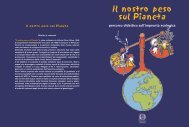Myanmar Protected Areas: Context, Current Status ... - Istituto Oikos
Myanmar Protected Areas: Context, Current Status ... - Istituto Oikos
Myanmar Protected Areas: Context, Current Status ... - Istituto Oikos
Create successful ePaper yourself
Turn your PDF publications into a flip-book with our unique Google optimized e-Paper software.
Background on <strong>Myanmar</strong><br />
XIV 1<br />
L. Beffasti<br />
1<br />
1.1<br />
Natural Features<br />
Introduction<br />
<strong>Myanmar</strong>, the largest country in South East Asia, is part of the Sundaic subregion of the Indo-Malayan<br />
Realm (MacKinnon and MacKinnon 1986). Due to the combination and interaction of geography,<br />
topography, climate, pattern of seasonal rainfall, presence of high mountains and major rivers, <strong>Myanmar</strong><br />
presents a great variety of different habitats and ecosystems supporting a rich biodiversity. With about<br />
half (48%) of mainland covered by forests (FAO 2010), <strong>Myanmar</strong> ranks 6 out of 11 among the Southeast<br />
Asian countries in terms of percentage of land area covered by forest (FAO 2009).<br />
Figure 1 <strong>Myanmar</strong> Land Area (Source: NCEA 2009b)<br />
Forest<br />
48%<br />
Other land<br />
16%<br />
Other wooded lands<br />
33%<br />
Inland water bodies<br />
3%<br />
Northern <strong>Myanmar</strong> presents the highest mountains with permanent snow and glaciers, with Mount<br />
Khakaborazi (6,000 m) being the highest in <strong>Myanmar</strong> and in South East Asia. The country includes<br />
extensive lowland plains, major rivers running parallel to each other, one of the largest river deltas in<br />
Asia (Ayeyawaddy Delta) and plateau around 1,000 m above sea level like the Shan Plateau. <strong>Myanmar</strong>,<br />
with its 2,280 km long coast and more than 800 small islands, has important coast and marine habitats<br />
supporting an abundance of species. The climate is a tropical monsoon climate with three distinctive<br />
seasons: hot season from March to May, rainy season from June to October, cold season from November<br />
to February, with high rainfall variability, from 500 mm in the Dry Zone up to over 6,000 mm in<br />
Tanintharyi Region and northern Rakhine State.<br />
Biodiversity<br />
About 250 mammal species, more than 1,000 birds, 370 reptiles and 7,000 plants are recorded in <strong>Myanmar</strong>,<br />
including 39 species of mammals, 45 of birds, 21 of reptiles and 38 of plants which are globally threatened<br />
(NCEA, 2009a). More species could be added since new discoveries continue to be made every year,<br />
including the exceptional discovery, during a survey of FFI and BANCA in Kachin state, of a new species<br />
of primate in 2010, the Burmese snub-nosed monkey Rhinopithecus strykeri, immediately classified as<br />
critically endangered by IUCN. 76 Key Biodiversity <strong>Areas</strong> (KBAs) have been identified, out of which 54<br />
are recognized as Important Birds <strong>Areas</strong> (IBAs) (BLI 2005). Endemism is relatively low compared to other<br />
countries in South East Asia. There are seven Endemic Birds <strong>Areas</strong> EBAs and secondary endemic areas<br />
(BLI 2005 and IUCN-WCPA 2007), three exclusively located in <strong>Myanmar</strong> (Eastern Himalayas, Irrawaddy<br />
plains and North <strong>Myanmar</strong> Lowlands), two stretching across <strong>Myanmar</strong> and Thailand (<strong>Myanmar</strong>-Thailand<br />
mountains and Peninsular Thailand lowland forests) and two others centered mainly in other countries<br />
but extending in <strong>Myanmar</strong> (Andaman Islands and Yunnan mountains). Natma Taung National Park is a<br />
particular area of local endemism.






